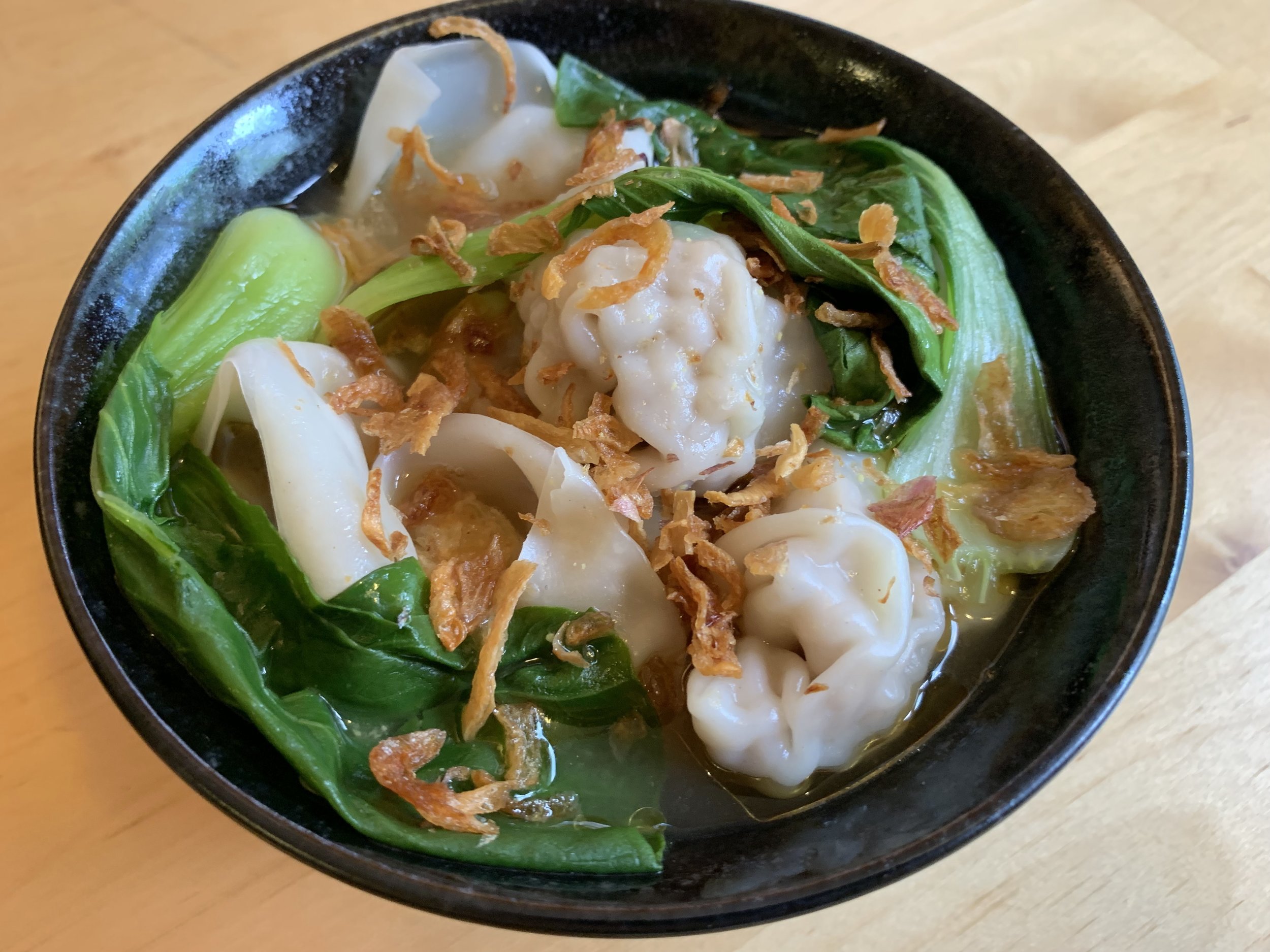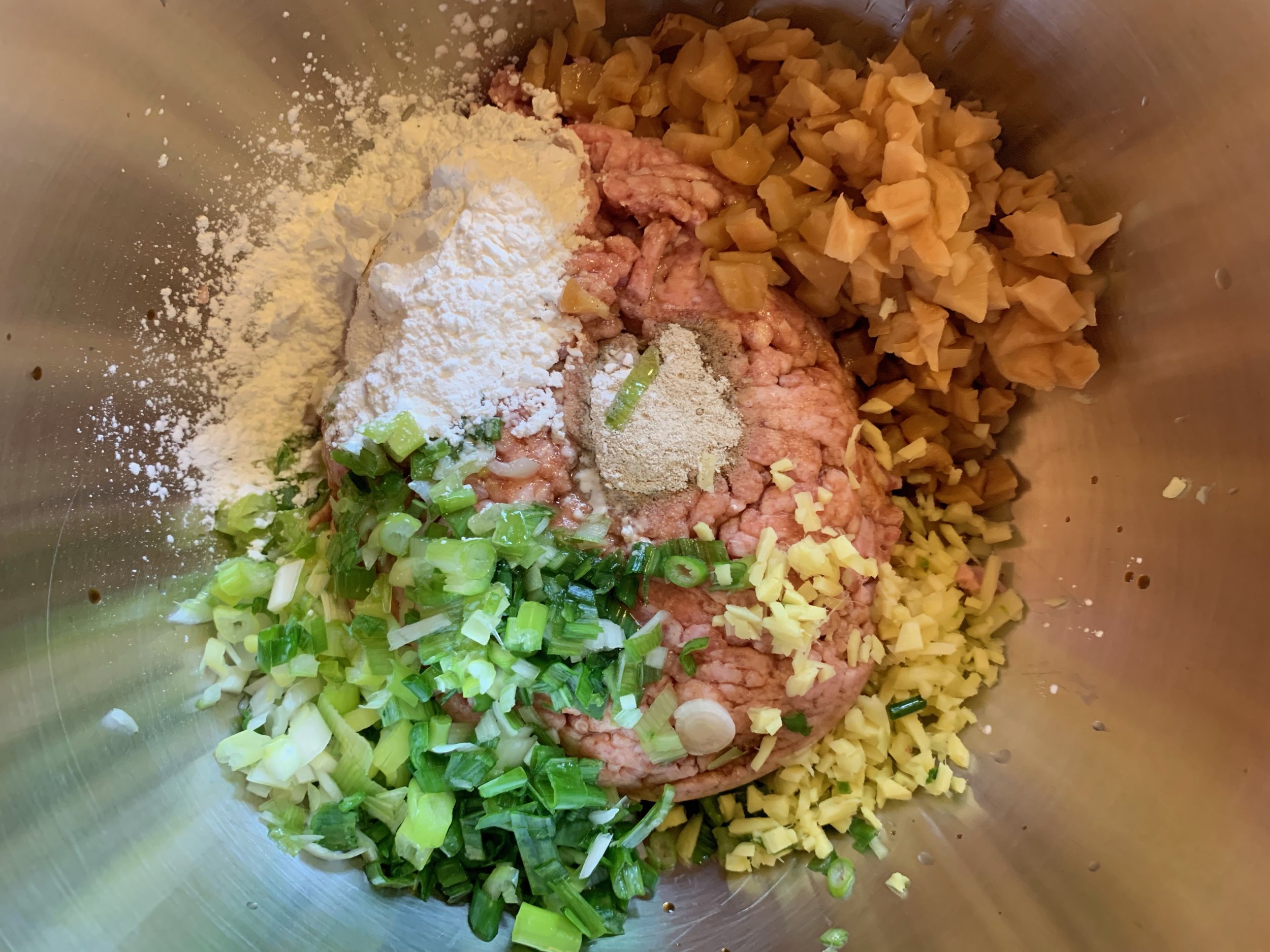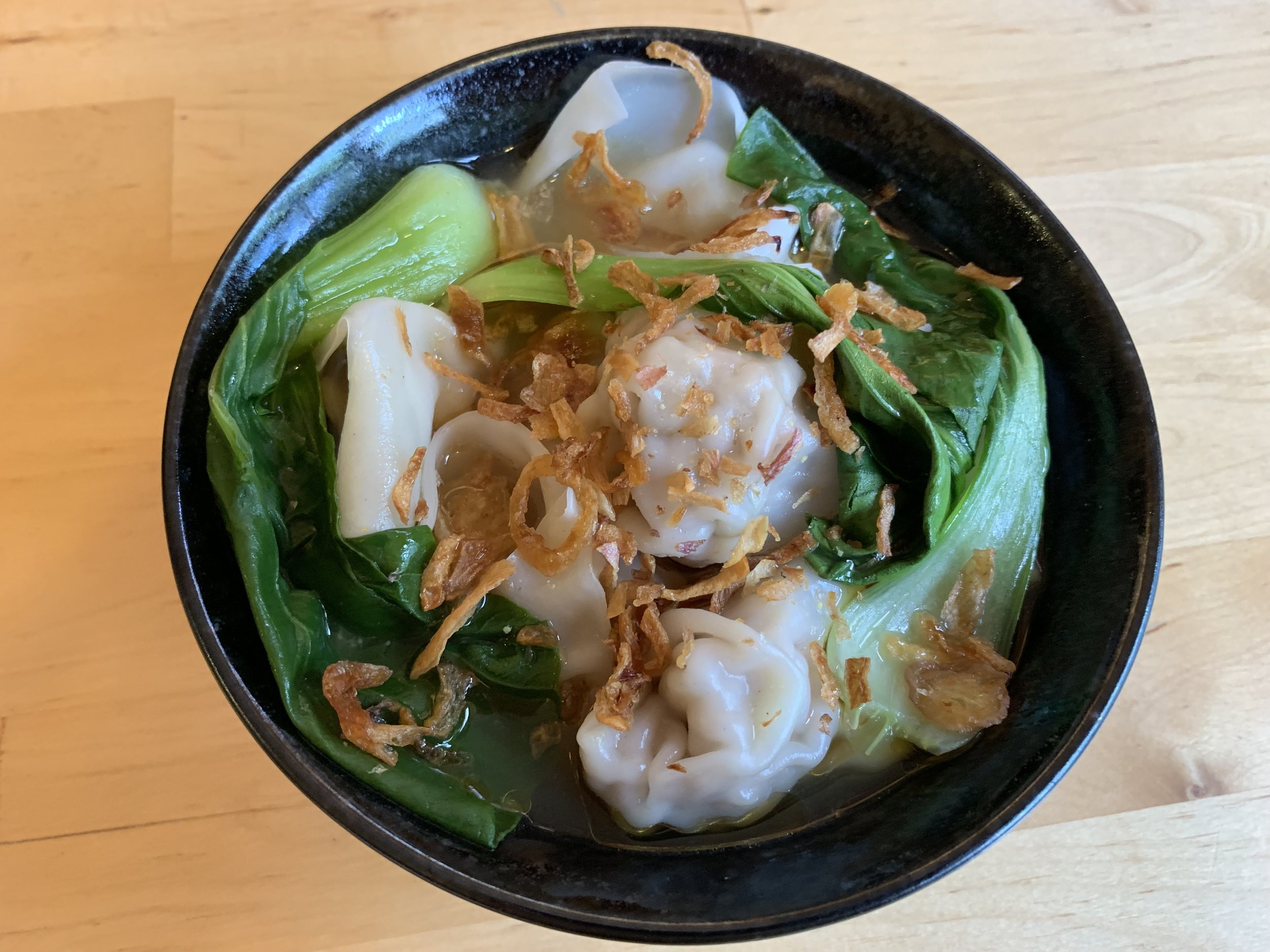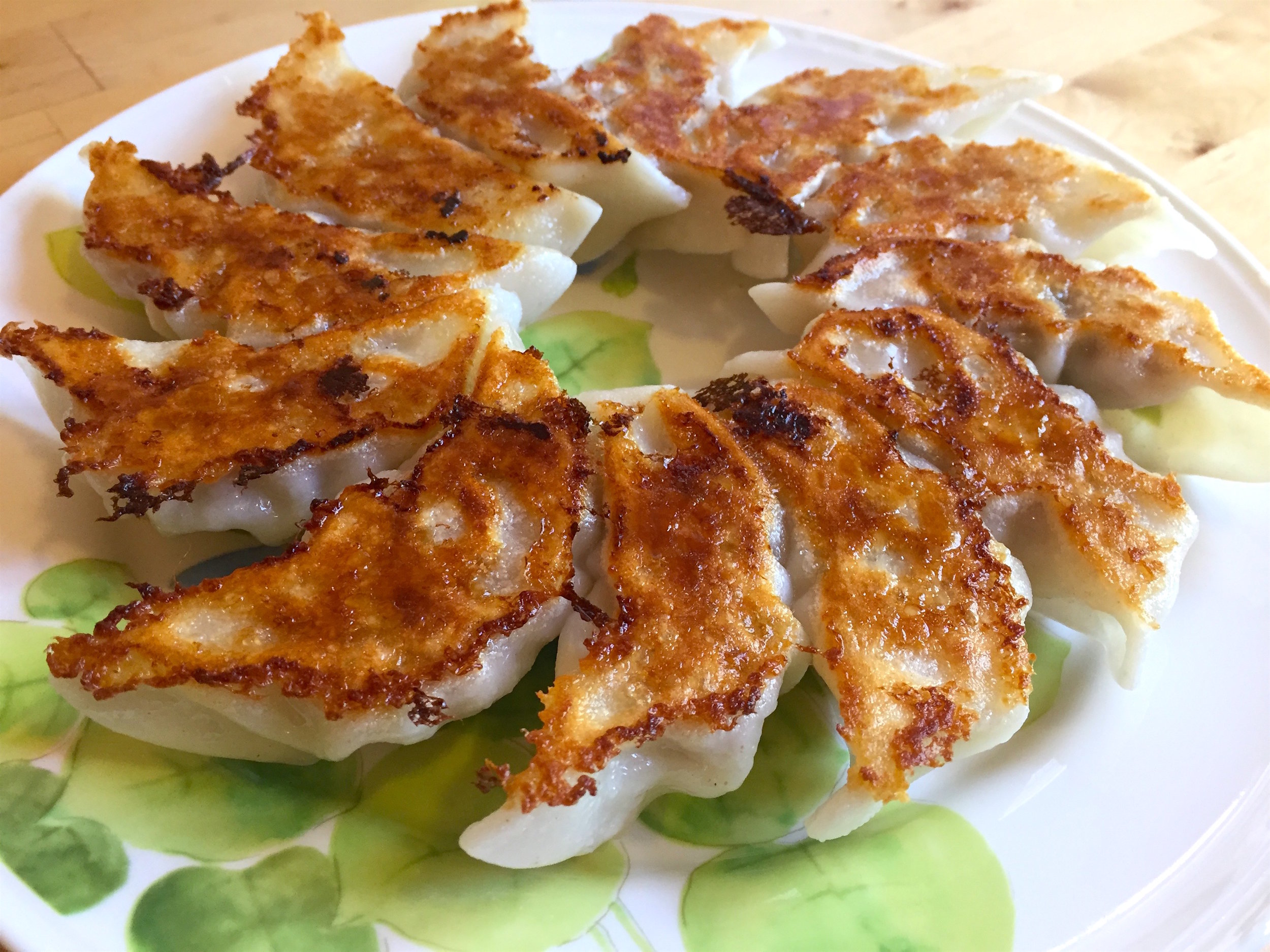Pork and Preserved Radish Wontons

豬肉菜脯馄饨 (Zhu Rou Cai Pu Hun Tun)
Salted and pickled vegetables are an essential part of the Chinese pantry, and come in an enormous variety. Preserved daikon radish (菜脯, cai pu or chai poh)[1] is a popular ingredient in Hakka and Cantonese cooking in particular. Traditionally made by salting slabs of daikon radish and then sun-drying them, preserved radish has a crunchy texture and a mild sweet and salty flavor. Preserved radish is often used in omelets, soups, and stir-fries, and while it can be an acquired taste, it is probably one of my favorite Chinese ingredients.
This preserved radish wonton is a family recipe from my grandparents in Taichung, Taiwan—a city where the cuisine is heavily influenced by Hakka cooking. The radish pairs well with the pork, and adds some texture to the wonton filling. This dish is one of my go-to comfort foods, a perfect pick-me-up for a rainy day. Here’s how to make them!
Ingredients
For the Wontons
1½ lb ground pork
5 oz preserved radish
1 pkg wonton wrappers
2 scallions, chopped
1½ inch ginger, minced
1 tbsp cornstarch
2 tsp soy sauce
2 tsp sesame oil
1 tbsp Shaoxing rice wine (optional)
½ tsp white pepper
Begin by preparing the preserved radish, first rinsing them, and then finely dicing. In keeping with the second cardinal rule of dumpling filling—the ingredients must be finely chopped—ensure that the radish pieces are no larger than ¼ inch. Because these radishes are preserved through salting, they are quite salty. We want to remove some of this salt by soaking the diced radish in a bowl of water for 10 minutes. While we wait for the radish to soak, we can prepare our other filling ingredients: finely mince the ginger and chop the scallions. Once the radish is done soaking, drain the water.
In a large bowl, combine the ground pork with the ginger, scallions, diced radish, 1 tablespoon of cornstarch, 2 teaspoons soy sauce, 2 teaspoon sesame oil, 1 tablespoon rice wine, and ½ teaspoon white pepper. Mix thoroughly with a large spoon or clean hands, until the mixture is homogeneous.
If you want to check for seasoning, the best way to do this is to take a small scoop of the filling and microwave it for 30 seconds or so, until it’s fully cooked. Adjust the seasoning to your taste, then prepare to wrap. You can prepare the filling up to two days in advance of wrapping if you wish. Cover tightly and store in the refrigerator.
On a clean table or counter, prepare a workspace for assembling the wontons. The wonton wrappers, if frozen, should be fully thawed. It is important to stop the wrappers from drying out, so depending on how fast you can work, and how humid the air is, it is often a good idea to keep the wrappers covered before wrapping, either with plastic wrap or a clean tea towel. A towel is also useful for drying your fingers. Fill a small bowl with cold water for sealing the wontons, and prepare a landing zone for the completed wontons. If you plan on cooking them all immediately, just go and pile the wontons up on a plate, but if you are planning on freezing them, prepare a plate, cutting board, or sheet pan covered in plastic wrap or parchment paper. The wontons should be placed in a single layer with a small amount of distance between them so they freeze individually.
When making wontons, any fold goes, as long as they are fully sealed and there are no large air bubbles. Some wonton styles are even made just by scrunching the wrapper together! Here, we demonstrate folding one of the traditional wonton shapes. Begin by placing a square wonton wrapper in the palm of your hand, and spooning about ½ a tablespoon of filling into the center. With your other hand, dip a finger in the cold water and moisten the edges of the wrapper. The water will help the wrapper stick to itself. Dry your finger on a towel, and then fold the square wrapper on the diagonal to form a triangle. Squeeze the air out and seal the triangle. Then bring the two corners of the triangle together, offset by a slight angle. Use a dab of water to press the two corners together, leaving the tips of the corners as two small ears.
If you intend on freezing the wontons, put your parchment or plastic wrap lined surface into the freezer. After 6 hours or so, the wontons should be rock solid. Transfer into a zipper storage bag for convenient storage in the freezer.
To Cook
To cook the wontons, bring a large pot of water to a boil. Plan for 4 wontons per diner for an appetizer, or 12 wontons per diner as a main course. When the water is boiling, add the wontons to the pot, stirring to prevent sticking. Make sure there is a generous amount of water, and the pot is not crowded. We don’t want the wontons to break apart in vigorous turbulence, so when the pot returns to a boil, turn the heat down to a simmer and cook, covered, until the wontons are done. This should be about 5 minutes for fresh wontons, or 10 minutes if you are cooking them from frozen. They are done with the skins turn translucent and the meat inside is fully cooked.
Ingredients
For the Soup
4 cups chicken stock
5 oz bok choy
1 tbsp soy sauce
2 tsp sesame oil
½ tsp white pepper
Crispy fried shallots (optional)
While the wontons cook, we can prepare a simple soup to serve them with. In a second pot, combine 4 cups chicken stock with 2 cups water, 1 tablespoon soy sauce, and ½ teaspoon white pepper (or to taste). Stir, and bring to a boil. When the soup boils, add the washed bok choy leaves and simmer for 5 minutes, or until the bok choy is tender. Remove the soup from the heat, and stir 2 teaspoons sesame oil.
When the wontons are done, remove them from the pot with a slotted spoon, and place them in a serving bowl. Ladle some soup over the wontons, and top the bowl with some additional sesame oil, chili oil if desired, and some crispy fried shallots.
Substitutions
Shiitake mushrooms are a great addition to the wonton filling mix. You can omit the preserved radish to make a pork wonton—if you do this, you should increase the amount of soy sauce in the filling, as the radish contributes a significant fraction of the salt in the filling. Water chestnuts provide a similar crunch, but differ in flavor. Most leafy green vegetables can be substituted for the bok choy in the soup. You can also add some chili oil to the soup for some spice.
If you’re in a rush, you can turn the two-pot preparation into a one-pot preparation by adding the bok choy to the same pot as the wontons, 5 minutes in. That way, the bok choy leaves and wontons will be done at about the same time. Meanwhile, pour a bit of soy sauce, sesame oil, and a sprinkle of white pepper into the bottom of your serving bowl. To serve, ladle the wontons and vegetables into the bowl, together with about a cup of the hot cooking water, creating some instant soup.
[1] Preserved radish is also known as “蘿蔔乾”(luo bo gan), which means “dried radish.” In English, this ingredient is translated very inconsistently. I’ve pretty much seen every possible combination of the following words: preserved/salted/sun-dried/pickled radish/turnip/daikon. Unfortunately, there are so many different types of Asian pickles and preserved foods made with daikon or other radishes that if you are not a Chinese speaker, you may be best off going by a combination of look and the ingredients list. High quality preserved radish should be made of daikon radish, salt, and maybe a bit of sugar, with no other flavorings and minimal preservatives.
Recipe
Prep Time: 1 hr Cook Time: 10 min Total Time: 1 hr 10 min
Difficulty: 3/5
Heat Sources: 2 burners
Equipment: 2 pots
Servings: 80 wontons, 6 (soup)
Ingredients
For the Wontons
1½ lb ground pork
5 oz preserved radish
1 pkg wonton wrappers
2 scallions, chopped
1½ inch ginger, minced
1 tbsp cornstarch
2 tsp soy sauce
2 tsp sesame oil
1 tbsp Shaoxing rice wine (optional)
½ tsp white pepper
For the Soup
4 cups chicken stock
5 oz bok choy
1 tbsp soy sauce
2 tsp sesame oil
½ tsp white pepper
Crispy fried shallots (optional)
Instructions
1. Dice the preserved radish into ¼ inch pieces, and soak them in cold water for 10 minutes.
2. In a large bowl, combine the ground pork, chopped scallions, minced ginger, cornstarch, 2 tsp soy sauce, sesame oil, Shaoxing rice wine, ½ tsp white pepper, and drained preserved radish pieces. Mix well to make the filling.
3. To begin assembly, prepare a small bowl of water, and unwrap the wonton wrappers, keeping them under plastic wrap or a clean tea towel.
4. To wrap, place a wonton wrapper in your hand. Spoon about ½ a tablespoon of filling in the center of the wrapper, and moisten the edges of the wrapper with water using the tip of your finger. Fold the wrapper over into a triangle, and bring the two corners of the triangle together. Repeat.
5. Once all the wontons are wrapped, cook immediately, or freeze.
To Cook
1. Bring a large pot of water to a boil, and add the wontons to the water.
2. When the pot returns to a boil, reduce the heat and simmer until fully cooked—about 5 minutes fresh, or 10 minutes frozen.
3. In a second pot, make the soup by combining the chicken stock, 2 cups of water, 1 tbsp soy sauce, and ½ tsp white pepper. Bring to a boil.
4. When the soup comes to a boil, add the bok choy leaves. Simmer for 5 minutes, or until the bok choy is tender. Remove the soup from the heat, and stir in the sesame oil.
5. Remove the cooked wontons from the pot with a slotted spoon, and place in a serving bowl.
6. Ladle the soup over the wontons, and top with crispy fried shallots.
























